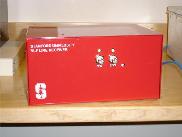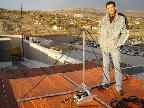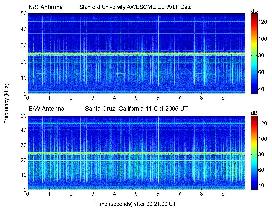|



 







|
The AWESOME Monitor - Space Weather Monitors
| The
AWESOME Monitor |
A tmospheric
W eather
E lectromagnetic
S ystem
for
O bservation
M odeling
and
E ducation
|
 |
| ** THESE INSTRUMENTS ARE NO LONGER AVAILABLE! **
|
Overview Presentations and Papers:
-
D. Scherrer, M. Cohen, To. Hoeksema, U. Inan, R. Mitchell, P. Scherrer,
"Distributing space weather monitoring instruments and educational materials worldwide for IHY 2007:
The AWESOME and SID project".
Advances in Space Research (a COSPAR publication) 42 (2008), 1777-1785.
-
VLF Remote Sensing of the Lower Ionosphere:
Solar Flares, Electron Precipitation, Sprites, and Giant gamma-ray Flares
(pdf) (an IHY presentation given at the Fall 2005 AGU)
- Stanford VLF Remote Sensing
(pdf)
(a presentation given at Goddard Space Flight Center)
- AWESOME Science Introduction (pdf)
- Cohen, M. B., U. S. Inan, E. W. Paschal (2010),
Sensitive broadband ELF/VLF radio reception with the AWESOME instrument, IEEE Trans. Geosc. Remote Sensing, Vol 48, Issue 1, Pages 3-17, doi:10.1109/TGRS.2009.2028334.
- Harriman, S. K., E. W. Paschal, U. S. Inan (2010),
Magnetic Sensor Design for Femtotesla Low-Frequency Signals>, IEEE Trans. Geosc. Remote Sensing, Vol 48, Issue 1, Pages 396-402, doi:10.1109/TGRS.2009.2027694.
-
AWESOME Overview Presentation (PowerPoint)
-
VLF Remote Sensing of the Lower Ionosphere: Solar Flares, Electron
Precipitation, Sprites, and Giant g-ray Flares (PowerPoint)
Technical Details:
- Deployment
Notes (pdf)
- AWESOME Preparations
(pdf)
- AWESOME Set Up
(pdf)
- AWESOME Software
(pdf)
- AWESOME Data
(pdf)
- VLF Transmitter
List (pdf)
- Matlab Scripts
(pdf)
Matlab Scripts Zip File
- Antennas
The AWESOME antenna is very simple. Details are given in the AWESOME Technical
Manual. All you need is a + on the ground, with each of the four spokes
of the + measuring 1.30m. Then you need a mast going verticle, with length
measuring 1.30m. It can be made with wood, aluminum, piping, whatever is
easiest. The two wire loops are right isosceles triangles, 2.60m base, 1.30m
height, and the loops are held in place by the apparatus. The apparatus
is somehow attached to the ground. More pictures, etc. available in the
Tech Manual.

AWESOME antenna in Elazig, Turkey
Sample Audio Data:
Since ELF and VLF studies fall in the 300 Hz - 30 kHz, they line
up well with the frequencies of audio recognition. Hence, we can listen to the
data stream as if it were audio. Here's a selected segment of data taken from
Palmer Station, Antarctica:
Sample AWESOME Audio Signal
In this file, listen for three distinct types of sounds. The
first and most prevalent is a series of clicks and pops. These signals, called
"radio atmospherics" are short bursts of radiation originating from lightning
strikes, which could be anywhere in the world. Most of the VLF/ELF energy released
by lightning is trapped between the Earth and ionosphere, and thus can travel
around the world. The second type signal you'll hear is a falling pitch, lasting
a couple seconds, known for this reason as a "whistler". Whistlers are also
comprised of energy released from lightning, except instead of propagating directly,
these signals actually escape the atmosphere entirely, propagate along magnetic
field lines and within the radiation belts (causing different frequencies to
travel at different speeds), and land at the other end, where they reenter the
atmosphere. The third and final noise is a VERY high pitched tone. You'll notice
a pattern to it -- 1,2,3....1,2,3... These are navigation beacons operated in
Russia, and are an example of a VLF transmitter, which can be used to remotely
sense disturbances in the ionosphere.
Data
The vertical lines on these spectrograms are "Radio Atmospherics"
from distant (or close by, depending on intensity) lightning flashes, while
the horizontal lines are the VLF transmitter signals, the phase and amplitude
of which give us the ionospheric remote sensing capability. The thicker solid
bars are calibration tones, regularly injected for setup but eventually removed.

Sample Santa Cruz, CA USA Data
Sites:
Related Projects and Articles:
|
|